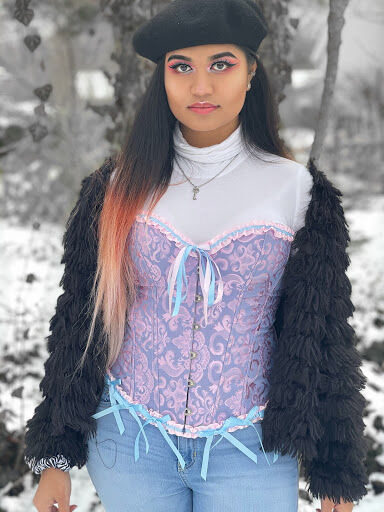‘Bridgerton’ ignites revival of corset trend
February 8, 2021
Fashion trends often resurface after a decade or two, but a recent trend emerged from the Regency period. Corsets, garments typically used to achieve a smaller waist, found their way into modern fashion with help from Netflix’s popular period drama “Bridgerton.”
Set in Regency England, “Bridgerton” is Netflix’s most streamed series with 82 million households tuning in, Deadline reported. Searches for corsets increased by 123% since the period drama premiered, according to Lyst insights. And as corsets continue to gain popularity, some college students are incorporating them into their wardrobes.
Sophomore fashion design major Amanda Fowler actively participates in this trend and owns multiple corsets. Fowler said they layer corsets with shirts, mesh tops and accessories.
“I adore corsets so much, I don’t know what it is about them,” Fowler said. “For me, I really like the historical aspect of them and I’m very, very big on fashion history.”
Freshman medical technology major Eindre Win also purchased a corset and cited “Bridgerton” and other period dramas as style influences. Win said she is interested in the “dreamy, Regency-core look” characteristic of the new Netflix series.
“It makes you feel much more confident and put together,” Win said. “There’s a sense that it’s a revival trend but it doesn’t feel old, it feels new to you still. It’s a way of testing out and meshing together a new fashion. I think it’s fun and I think a lot of people do enjoy that — taking old things and making it into something new.”
Throughout history, corsets functioned as staples in women’s fashion and reflected stylish silhouettes from their specific time periods. While evidence of corset-like attire dates back to 1600 BC, they entered fashion as prominent garments around the 16th century, according to Encyclopedia Britannica.
Early corsets were made of whalebone or horn and called “whalebone bodies.” In the early 17th century, corsets shifted to a conical shape and the neckline lowered. Corsets, or stays, maintained the conical silhouette into the 18th century, according to the Fine Arts Museums of San Francisco.
“You have this big rupture at the end of the 18th century into the beginning of the 19th century where the corset sort of radically changes, or you have this radical abandonment of these really stiff, heavy undergarments in favor of a much more natural, human form and they were much more interested in this Neoclassical idea of the body,” said Sara Hume, Kent State University Museum curator and associate professor.
The French Revolution caused a brief abandonment of the corset because aristocratic fashions were discouraged, but it reappeared in the 19th century with a lowered waist and a preference for the hourglass silhouette, according to the Fine Arts Museums of San Francisco.
At the beginning of the 20th century, the S-bend corset emerged and it pushed the hips back so the body looked like the letter “S,” according to Lucy’s Corsetry. After turmoil in the early 1900s, Hume said women largely abandoned corsets in the 1920s in favor of bras and girdles. As the century progressed, designers such as Christian Dior reintroduced corsets into high fashion, according to the Fine Arts Museums of San Francisco.
Some modern interpretations of corsets, including that of “Bridgerton,” show scenes of tightly laced corsets with actresses struggling to breathe. Hume said this portrayal of extremely tight corsets is an exaggeration.
“When you look at clothes from the 19th century, it tends to be very restrictive and so our idea of comfort and freedom has to do with loose-fitting clothing that we wear, like pants, that allow you the freedom of movement,” Hume said. “So we tend to look back at the restrictive, structured clothes of the 19th century and think it was very tortured and uncomfortable, but a lot of it is our present idea of comfort and freedom that comes from events of the 20th century.”
Corsets serve different purposes and accompany different aesthetics, as seen in the contrast of Win and Fowler’s styles. Win said she is interested in cottagecore, an aesthetic that stresses floral prints, dresses and a whimsical attitude, according to HuffPost, and combines her love of corsets with elements of this aesthetic.
“I think part of why people are so drawn to it is because with cottagecore, you kind of feel a sense of independence and freedom because the whole vibe gives off ‘running in the fields and being free from worry,’” Win said. “It’s a very dreamy-type concept, which I think a lot of people are drawn to.”
On the other hand, Fowler said they embrace a dark, edgy aesthetic. They pair corsets with multiple layers and their signature knife earrings, directly contrasting the cottagecore aesthetic.
“A bunch of my style inspirations are glam rock, so like David Bowie, Prince, Elton John, you know, icons [like] them,” Fowler said. “But I definitely fall into a darker category.”
With room for varying aesthetics, the corset trend can add style to any wardrobe. While some may feel hesitant to participate in a popular trend, Fowler said to just go for it.
“Obviously, a lot of us weren’t here to try it the first time,” Fowler said. “So why not try it in a more contemporary setting?”
Catie Pusateri is a reporter. Contact her at [email protected].












